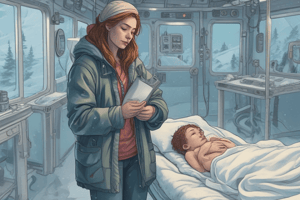Podcast
Questions and Answers
Which of these findings would present earliest in a patient with hypothermia?
Which of these findings would present earliest in a patient with hypothermia?
Shivering
What should the EMT state about the spider bite encountered at the residence?
What should the EMT state about the spider bite encountered at the residence?
"You really need to go because the bite of that spider does not heal very well and will put you at risk for infection."
How should the EMT assess the skin temperature of a patient exposed to cold?
How should the EMT assess the skin temperature of a patient exposed to cold?
Places the back of his hand on the patient's abdomen
What is the appropriate care for a confused teenage boy in the heat with a weak pulse?
What is the appropriate care for a confused teenage boy in the heat with a weak pulse?
What is the most significant mechanism by which the body can lose heat?
What is the most significant mechanism by which the body can lose heat?
What is the best option for providing oxygen to a patient with a core temperature of 95 degrees F?
What is the best option for providing oxygen to a patient with a core temperature of 95 degrees F?
What statement would be most appropriate for a patient refusing care after tick removal?
What statement would be most appropriate for a patient refusing care after tick removal?
What finding is of most concern when cooling a patient with possible heat stroke?
What finding is of most concern when cooling a patient with possible heat stroke?
What action would be most beneficial to an unresponsive patient with hot, dry skin?
What action would be most beneficial to an unresponsive patient with hot, dry skin?
What finding is most concerning in a confused patient exposed to high temperatures?
What finding is most concerning in a confused patient exposed to high temperatures?
What will most likely occur without treatment in an 18-month-old with a temperature of 105.2 degrees F?
What will most likely occur without treatment in an 18-month-old with a temperature of 105.2 degrees F?
What statement made by a patient after rewarming a freezing cold injury is concerning?
What statement made by a patient after rewarming a freezing cold injury is concerning?
What question should be asked when obtaining a history of a 5-year-old boy with generalized hypothermia?
What question should be asked when obtaining a history of a 5-year-old boy with generalized hypothermia?
What instruction is most appropriate when moving a patient with severe generalized hypothermia?
What instruction is most appropriate when moving a patient with severe generalized hypothermia?
Which thermometer should be utilized by an EMT when assessing the temperature of a patient with hypothermia?
Which thermometer should be utilized by an EMT when assessing the temperature of a patient with hypothermia?
Flashcards are hidden until you start studying
Study Notes
Hypothermia and Temperature Regulation
- Shivering is the earliest finding in patients with hypothermia, indicating the body's response to cold.
- Skin Temperature Assessment: Use the back of the hand to assess patient's abdomen for accurate skin temperature.
- Heat Loss Mechanism: The most significant way the body loses heat is through radiation.
Spider Bite Management
- A brown recluse spider bite may lead to serious complications, such as infection, which necessitates medical attention despite the absence of immediate pain.
Heat-Related Illnesses
- For a patient exhibiting signs of heat exhaustion (pale, cool, moist skin), placing them supine with elevated feet can improve circulation.
- When treating heat stroke, the presence of shivering after cold packs are applied is a concerning sign, indicating the body is trying to rewarm itself.
- In a case of heat stroke with unresponsive patient and hot, dry skin, applying cold packs to the groin and armpits can help lower body temperature effectively.
Pediatric Temperature Concerns
- An 18-month-old with a fever of 105.2°F is at risk for cellular dysfunction or seizures if untreated.
Tick Bite Risks
- Informing patients about the risk of bacterial infections from tick bites is crucial, even if they refuse treatment.
Cold Injury Management
- Following rewarming of a freezing injury, lack of pain when rubbing fingers together can indicate serious nerve damage.
- During the transport of a patient with severe hypothermia, emphasize gentle movement to prevent cardiac arrest.
Assessment and Observation
- When assessing a young child with generalized hypothermia, prioritize asking, "How long was he out in the cold?" to understand exposure duration.
- Use a medical-grade thermometer to check rectal temperature for accurate readings in hypothermic patients.
Elderly Considerations
- Be alert to confusion and coldness in elderly patients, especially those who have been immobile for extended periods, as they are at higher risk for hypothermia.
Studying That Suits You
Use AI to generate personalized quizzes and flashcards to suit your learning preferences.




